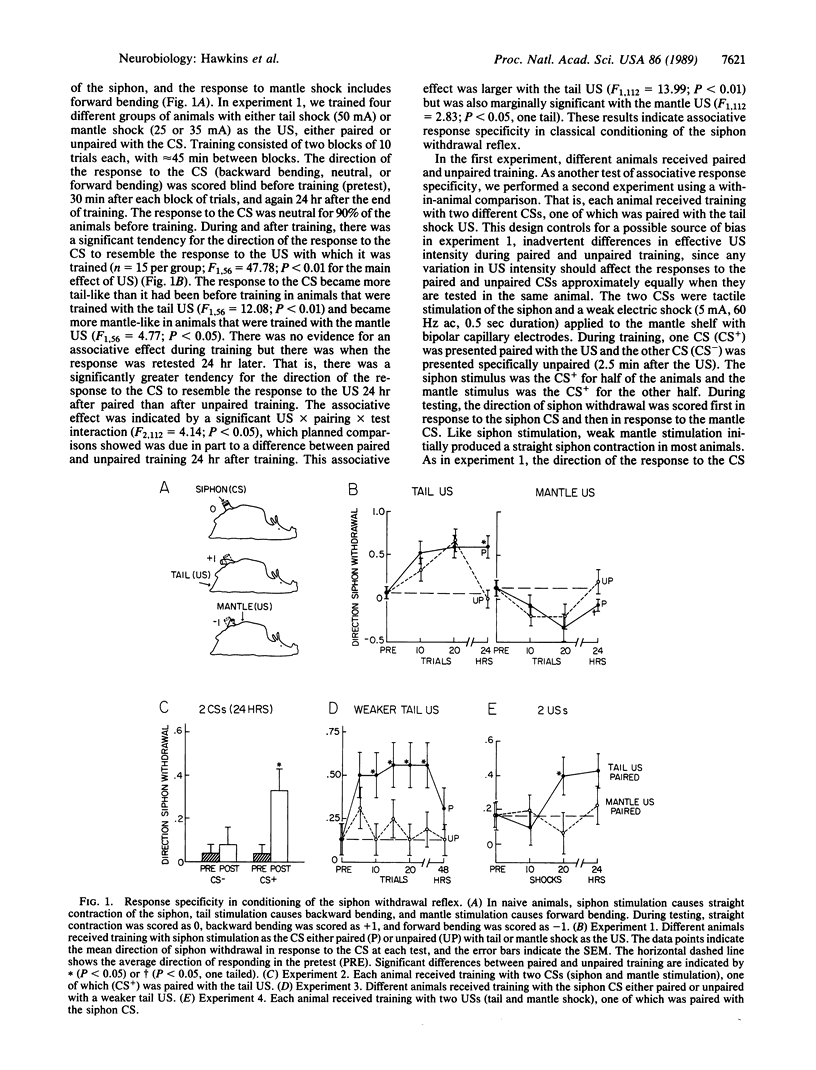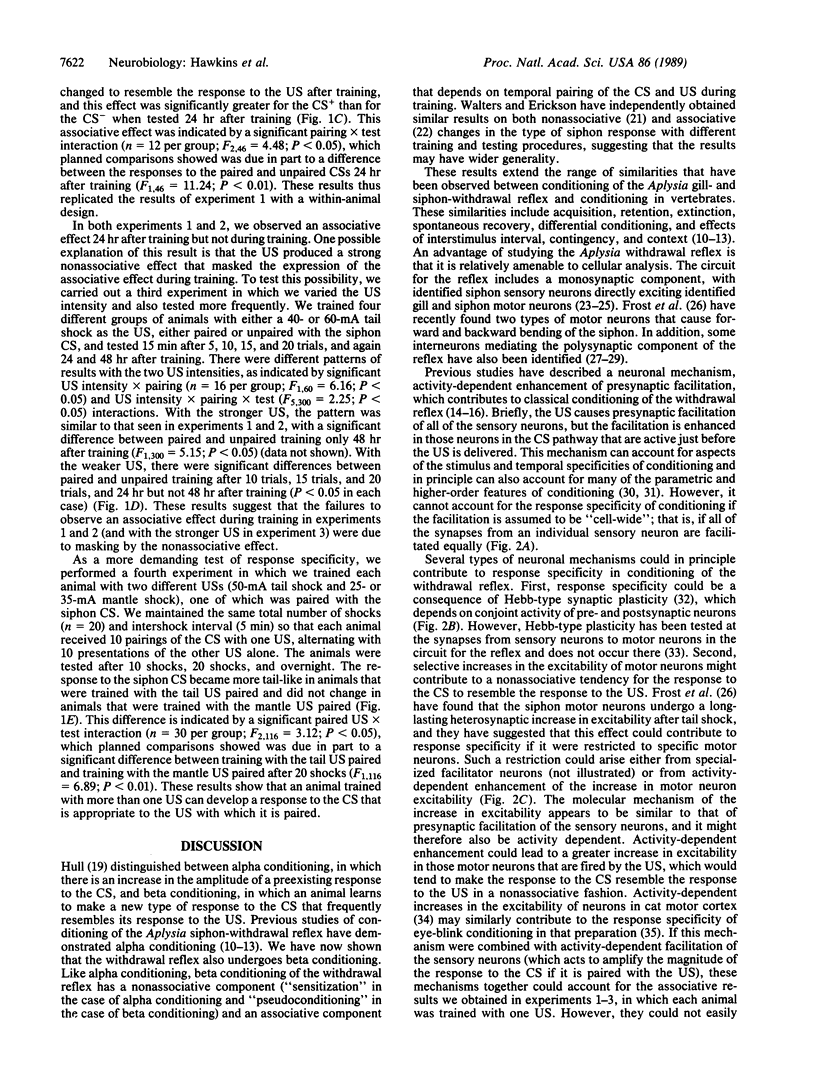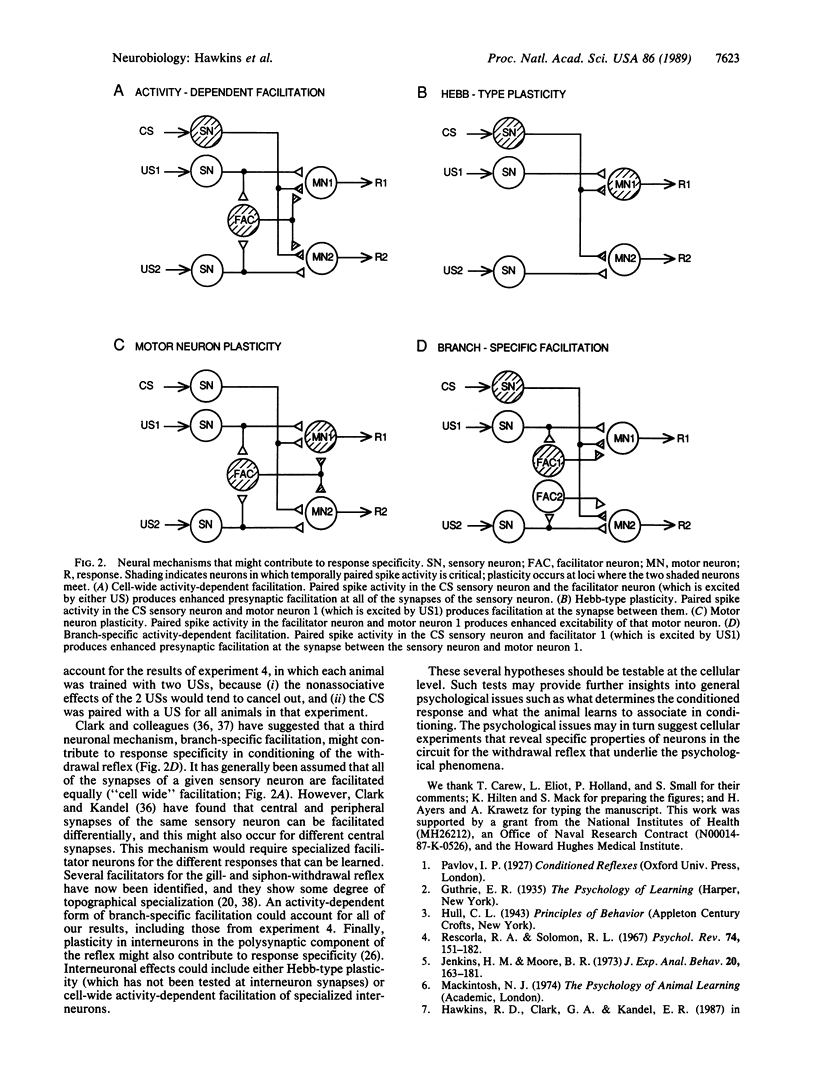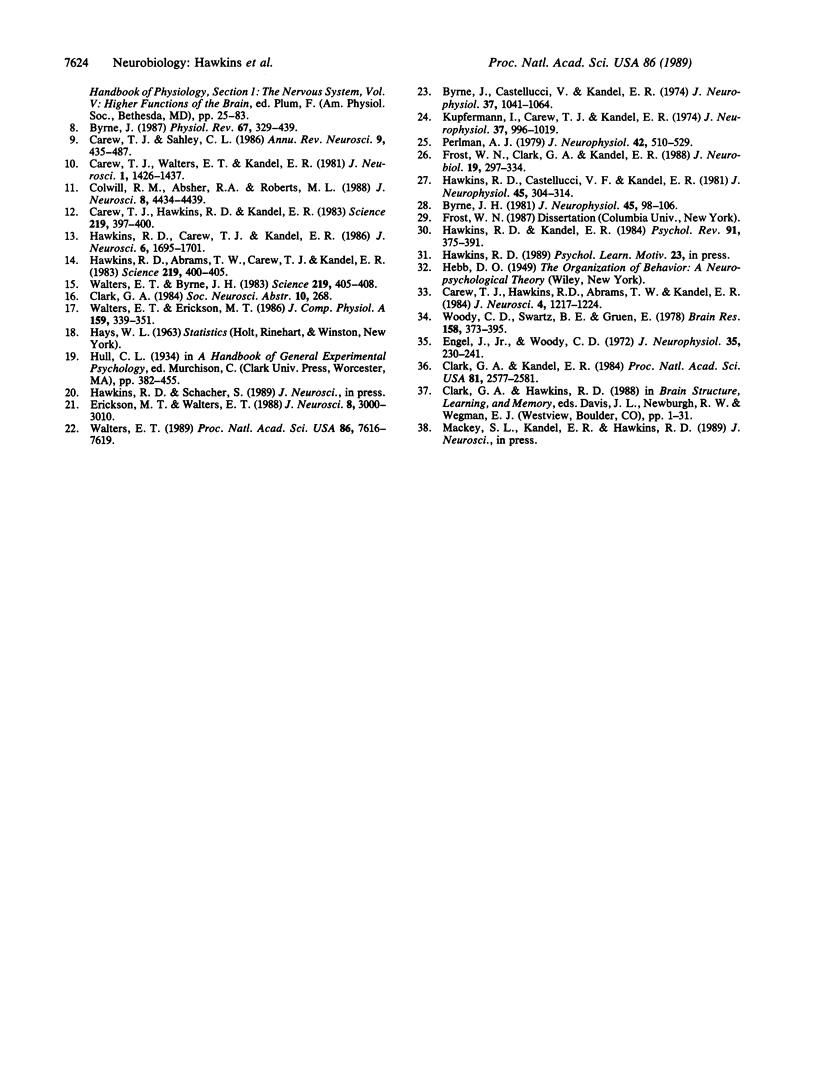Abstract
The gill- and siphon-withdrawal reflex of Aplysia undergoes classical conditioning of its amplitude and duration when siphon stimulation (the conditioned stimulus, CS) is paired with tail or mantle shock (the unconditioned stimulus, US). This conditioning of a preexisting response exhibits both temporal and stimulus specificities, which can be accounted for by activity-dependent enhancement of presynaptic facilitation of the siphon sensory neurons. To test whether conditioning of the reflex also exhibits response specificity (development of a new type of response to the CS that often resembles the response to the US), we measured the direction of siphon withdrawal in response to siphon stimulation (the CS) with tail or mantle shock as the US. The unlearned response to siphon stimulation is straight contraction, the response to tail shock is backward bending, and the response to mantle shock is forward bending. In the first experiment, we trained different animals with the tail or mantle US paired or unpaired with the CS; in a second experiment, we trained each animal with two CSs, one of which was paired with the US; in a third experiment, we varied US intensity; and in a fourth experiment, we trained each animal with two USs, one of which was paired with the CS. There was a significant, pairing-specific tendency for the direction of the response to the CS to resemble the response to the US after training in each experiment, demonstrating response specificity in conditioning of the withdrawal reflex. This feature of conditioning could in principle be accounted for by an elaboration of activity-dependent facilitation.
Full text
PDF




Selected References
These references are in PubMed. This may not be the complete list of references from this article.
- Byrne J. H. Cellular analysis of associative learning. Physiol Rev. 1987 Apr;67(2):329–439. doi: 10.1152/physrev.1987.67.2.329. [DOI] [PubMed] [Google Scholar]
- Byrne J. H. Comparative aspects of neural circuits for inking behavior and gill withdrawal in Aplysia californica. J Neurophysiol. 1981 Jan;45(1):98–106. doi: 10.1152/jn.1981.45.1.98. [DOI] [PubMed] [Google Scholar]
- Byrne J., Castellucci V., Kandel E. R. Receptive fields and response properties of mechanoreceptor neurons innervating siphon skin and mantle shelf in Aplysia. J Neurophysiol. 1974 Sep;37(5):1041–1064. doi: 10.1152/jn.1974.37.5.1041. [DOI] [PubMed] [Google Scholar]
- Carew T. J., Hawkins R. D., Abrams T. W., Kandel E. R. A test of Hebb's postulate at identified synapses which mediate classical conditioning in Aplysia. J Neurosci. 1984 May;4(5):1217–1224. doi: 10.1523/JNEUROSCI.04-05-01217.1984. [DOI] [PMC free article] [PubMed] [Google Scholar]
- Carew T. J., Hawkins R. D., Kandel E. R. Differential classical conditioning of a defensive withdrawal reflex in Aplysia californica. Science. 1983 Jan 28;219(4583):397–400. doi: 10.1126/science.6681571. [DOI] [PubMed] [Google Scholar]
- Carew T. J., Sahley C. L. Invertebrate learning and memory: from behavior to molecules. Annu Rev Neurosci. 1986;9:435–487. doi: 10.1146/annurev.ne.09.030186.002251. [DOI] [PubMed] [Google Scholar]
- Carew T. J., Walters E. T., Kandel E. R. Classical conditioning in a simple withdrawal reflex in Aplysia californica. J Neurosci. 1981 Dec;1(12):1426–1437. doi: 10.1523/JNEUROSCI.01-12-01426.1981. [DOI] [PMC free article] [PubMed] [Google Scholar]
- Clark G. A., Kandel E. R. Branch-specific heterosynaptic facilitation in Aplysia siphon sensory cells. Proc Natl Acad Sci U S A. 1984 Apr;81(8):2577–2581. doi: 10.1073/pnas.81.8.2577. [DOI] [PMC free article] [PubMed] [Google Scholar]
- Colwill R. M., Absher R. A., Roberts M. L. Context-US learning in Aplysia californica. J Neurosci. 1988 Dec;8(12):4434–4439. doi: 10.1523/JNEUROSCI.08-12-04434.1988. [DOI] [PMC free article] [PubMed] [Google Scholar]
- Erickson M. T., Walters E. T. Differential expression of pseudoconditioning and sensitization by siphon responses in Aplysia: novel response selection after training. J Neurosci. 1988 Aug;8(8):3000–3010. doi: 10.1523/JNEUROSCI.08-08-03000.1988. [DOI] [PMC free article] [PubMed] [Google Scholar]
- Frost W. N., Clark G. A., Kandel E. R. Parallel processing of short-term memory for sensitization in Aplysia. J Neurobiol. 1988 Jun;19(4):297–334. doi: 10.1002/neu.480190402. [DOI] [PubMed] [Google Scholar]
- Hawkins R. D., Abrams T. W., Carew T. J., Kandel E. R. A cellular mechanism of classical conditioning in Aplysia: activity-dependent amplification of presynaptic facilitation. Science. 1983 Jan 28;219(4583):400–405. doi: 10.1126/science.6294833. [DOI] [PubMed] [Google Scholar]
- Hawkins R. D., Carew T. J., Kandel E. R. Effects of interstimulus interval and contingency on classical conditioning of the Aplysia siphon withdrawal reflex. J Neurosci. 1986 Jun;6(6):1695–1701. doi: 10.1523/JNEUROSCI.06-06-01695.1986. [DOI] [PMC free article] [PubMed] [Google Scholar]
- Hawkins R. D., Castellucci V. F., Kandel E. R. Interneurons involved in mediation and modulation of gill-withdrawal reflex in Aplysia. I. Identification and characterization. J Neurophysiol. 1981 Feb;45(2):304–314. doi: 10.1152/jn.1981.45.2.304. [DOI] [PubMed] [Google Scholar]
- Hawkins R. D., Kandel E. R. Is there a cell-biological alphabet for simple forms of learning? Psychol Rev. 1984 Jul;91(3):375–391. [PubMed] [Google Scholar]
- Jenkins H. M., Moore B. R. The form of the auto-shaped response with food or water reinforcers. J Exp Anal Behav. 1973 Sep;20(2):163–181. doi: 10.1901/jeab.1973.20-163. [DOI] [PMC free article] [PubMed] [Google Scholar]
- Kupfermann I., Carew T. J., Kandel E. R. Local, reflex, and central commands controlling gill and siphon movements in Aplysia. J Neurophysiol. 1974 Sep;37(5):996–1019. doi: 10.1152/jn.1974.37.5.996. [DOI] [PubMed] [Google Scholar]
- Perlman A. J. Central and peripheral control of siphon-withdrawal reflex in Aplysia californica. J Neurophysiol. 1979 Mar;42(2):510–529. doi: 10.1152/jn.1979.42.2.510. [DOI] [PubMed] [Google Scholar]
- Rescorla R. A., Solomon R. L. Two-process learning theory: Relationships between Pavlovian conditioning and instrumental learning. Psychol Rev. 1967 May;74(3):151–182. doi: 10.1037/h0024475. [DOI] [PubMed] [Google Scholar]
- Walters E. T., Byrne J. H. Associative conditioning of single sensory neurons suggests a cellular mechanism for learning. Science. 1983 Jan 28;219(4583):405–408. doi: 10.1126/science.6294834. [DOI] [PubMed] [Google Scholar]
- Walters E. T., Erickson M. T. Directional control and the functional organization of defensive responses in Aplysia. J Comp Physiol A. 1986 Sep;159(3):339–351. doi: 10.1007/BF00603980. [DOI] [PubMed] [Google Scholar]
- Walters E. T. Transformation of siphon responses during conditioning of Aplysia suggests a model of primitive stimulus-response association. Proc Natl Acad Sci U S A. 1989 Oct;86(19):7616–7619. doi: 10.1073/pnas.86.19.7616. [DOI] [PMC free article] [PubMed] [Google Scholar]
- Woody C. D., Engel J., Jr Changes in unit activity and thresholds to electrical microstimulation at coronal-pericruciate cortex of cat with classical conditioning of different facial movements. J Neurophysiol. 1972 Mar;35(2):230–241. doi: 10.1152/jn.1972.35.2.230. [DOI] [PubMed] [Google Scholar]
- Woody C. D., Swartz B. E., Gruen E. Effects of acetylcholine and cyclic GMP on input resistance of cortical neurons in awake cats. Brain Res. 1978 Dec 15;158(2):373–395. doi: 10.1016/0006-8993(78)90682-0. [DOI] [PubMed] [Google Scholar]


